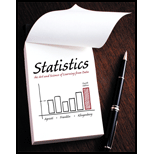
Concept explainers
Checking guidelines For Example 13 on the gender distribution of promotions, the population size was more than one thousand, half of whom were female. The
a. Check whether the guideline was satisfied about the relative sizes of the population and the sample, thus allowing you to use the binomial for the
b. Check whether the guideline was satisfied for this binomial distribution to be approximated well by a
Example 13
Testing for Gender Bias in Promotions
Picture the Scenario
Example 1 introduced a case involving possible discrimination against female employees. A group of women employees has claimed that female employees are less likely than male employees of similar qualifications to be promoted.
Question to Explore
Suppose the large employee pool that can be tapped for management training is half female and half male. In a group recently selected for promotion, none of the 10 individuals chosen were female. What would be the probability of 0 females in 10 selections, if there truly were no gender bias?
Think It Through
If there is no gender bias, other factors being equal, at each choice the probability of selecting a female equals 0.50 and the probability of selecting a male equals 0.50. Let X denote the number of females selected for promotion in a random sample of 10 employees. Then, the possible values for X are 0, 1, …,10, and X has the binomial distribution with n = 10 and p = 0.50. For each x between 0 and 10, we can find the probability that x of the 10 people selected are female using the binomial formula
The probability that no females are chosen (x = 0) equals
Any number raised to the power of 0 equals 1. Also, 0! = 1, and the 10! terms in the numerator and denominator divide out. leaving P(0) = (0.50)10. If the employees were chosen randomly, it is very unlikely (one chance in a thousand) that none of the 10 selected for promotion would have been female.
Insight
In summary, because this probability is so small, seeing no women chosen would make us highly skeptical that the choices were random with respect to gender.
Want to see the full answer?
Check out a sample textbook solution
Chapter 6 Solutions
Statistics: The Art and Science of Learning From Data, Books a la Carte Edition (4th Edition)
- A well-known company predominantly makes flat pack furniture for students. Variability with the automated machinery means the wood components are cut with a standard deviation in length of 0.45 mm. After they are cut the components are measured. If their length is more than 1.2 mm from the required length, the components are rejected. a) Calculate the percentage of components that get rejected. b) In a manufacturing run of 1000 units, how many are expected to be rejected? c) The company wishes to install more accurate equipment in order to reduce the rejection rate by one-half, using the same ±1.2mm rejection criterion. Calculate the maximum acceptable standard deviation of the new process.arrow_forward5. Let X and Y be independent random variables and let the superscripts denote symmetrization (recall Sect. 3.6). Show that (X + Y) X+ys.arrow_forward8. Suppose that the moments of the random variable X are constant, that is, suppose that EX" =c for all n ≥ 1, for some constant c. Find the distribution of X.arrow_forward
- 9. The concentration function of a random variable X is defined as Qx(h) = sup P(x ≤ X ≤x+h), h>0. Show that, if X and Y are independent random variables, then Qx+y (h) min{Qx(h). Qr (h)).arrow_forward10. Prove that, if (t)=1+0(12) as asf->> O is a characteristic function, then p = 1.arrow_forward9. The concentration function of a random variable X is defined as Qx(h) sup P(x ≤x≤x+h), h>0. (b) Is it true that Qx(ah) =aQx (h)?arrow_forward
- 3. Let X1, X2,..., X, be independent, Exp(1)-distributed random variables, and set V₁₁ = max Xk and W₁ = X₁+x+x+ Isk≤narrow_forward7. Consider the function (t)=(1+|t|)e, ER. (a) Prove that is a characteristic function. (b) Prove that the corresponding distribution is absolutely continuous. (c) Prove, departing from itself, that the distribution has finite mean and variance. (d) Prove, without computation, that the mean equals 0. (e) Compute the density.arrow_forward1. Show, by using characteristic, or moment generating functions, that if fx(x) = ½ex, -∞0 < x < ∞, then XY₁ - Y2, where Y₁ and Y2 are independent, exponentially distributed random variables.arrow_forward
- 1. Show, by using characteristic, or moment generating functions, that if 1 fx(x): x) = ½exarrow_forward1990) 02-02 50% mesob berceus +7 What's the probability of getting more than 1 head on 10 flips of a fair coin?arrow_forward9. The concentration function of a random variable X is defined as Qx(h) sup P(x≤x≤x+h), h>0. = x (a) Show that Qx+b(h) = Qx(h).arrow_forward
 Glencoe Algebra 1, Student Edition, 9780079039897...AlgebraISBN:9780079039897Author:CarterPublisher:McGraw Hill
Glencoe Algebra 1, Student Edition, 9780079039897...AlgebraISBN:9780079039897Author:CarterPublisher:McGraw Hill

